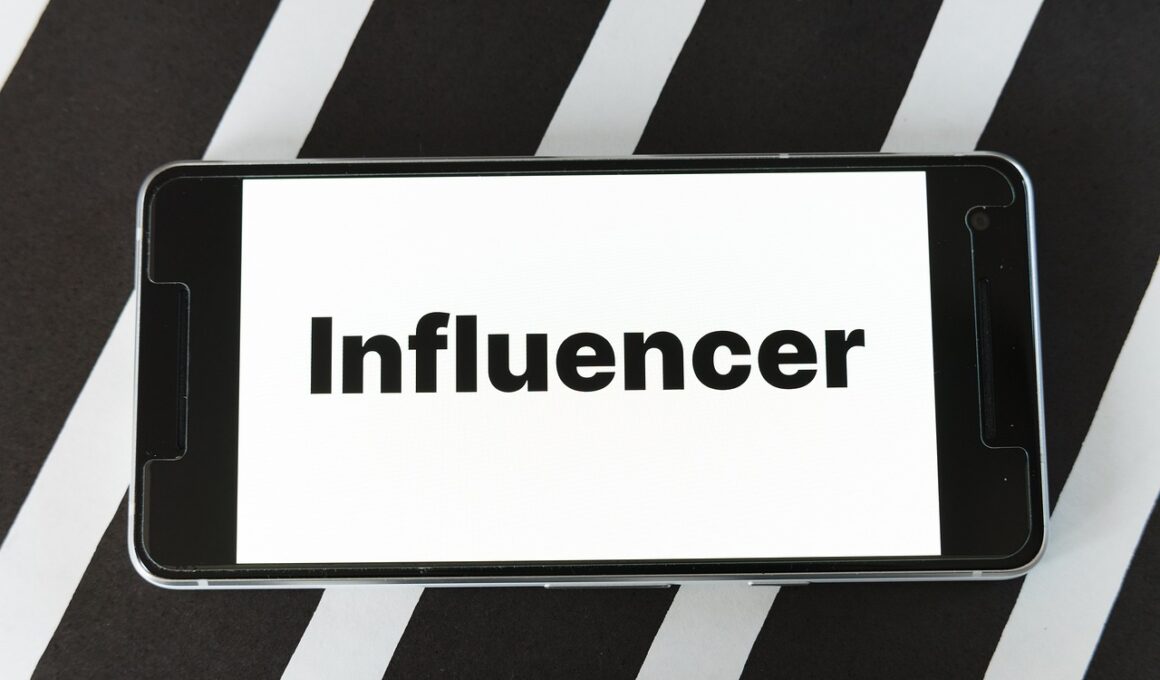Best Platforms to Launch Influencer Marketing Campaigns
Influencer marketing has emerged as a crucial strategy for brands seeking to reach wider audiences and enhance their credibility. The effectiveness of influencer marketing heavily relies on choosing the right platforms to conduct such campaigns. Different platforms serve distinct purposes and audiences, making selection critical. The prominent platforms for influencer marketing include Instagram, YouTube, TikTok, and more. Each platform offers unique ways to connect with potential customers, engaging them through authentic and relatable content. Alongside audience demographics, brands must consider the type of content they want to promote, be it photos, videos, or blog posts. Engagement rates and past campaign performances should also influence decisions to ensure successful influencer partnerships. Metrics like impressions, clicks, and conversions significantly impact evaluating success. Instagram continues to dominate, with its visual nature, while TikTok is rapidly gaining popularity with its short video format. Each platform has tailored tools for influencer interaction, allowing brands to optimize their campaigns effectively. Collaborating with niche influencers can generate better results, allowing marketing efforts to resonate strongly with targeted audiences, driving conversions in the competitive digital landscape.
When considering platforms for influencer marketing, understanding each platform’s audience is paramount. For brands targeting a younger demographic, TikTok may be ideal due to its massive popularity among Gen Z users. TikTok allows creative flexibility, providing opportunities for engaging storytelling through short video clips. Brands can leverage trending challenges and hashtags to gain visibility while encouraging user-generated content. Other platforms like YouTube excel in long-form content, making it suitable for detailed product reviews and tutorials. Successful YouTube campaigns often involve collaboration with creators who have established trust with their followers. Additionally, Instagram remains a versatile platform, offering features such as Stories, IGTV, and Reels, which can cater to various content styles. Brands should utilize analytics tools offered by these platforms to gauge audience engagement and optimize their influencer partnerships. By analyzing audience insights, brands can tailor their messages to ensure they resonate with their desired demographic. Each platform provides unique opportunities for cultivating connections, significantly impacting campaign success. Hence, marketers must analyze each platform’s unique characteristics and audience preferences to devise a tailored strategy for their influencer marketing campaigns, maximizing reach and engagement.
Instagram’s Role in Influencer Marketing
Instagram has transformed influencer marketing, making it one of the leading platforms for brand collaborations. With its visually-driven approach, Instagram fosters authentic connections between influencers and their audiences. Influencers share lifestyle-oriented content that resonates with their followers, making advertising feel organic rather than intrusive. The platform’s features, such as Stories and Reels, offer dynamic ways for brands to promote their products. Brands can create engaging, temporary content to showcase new launches or promotions, harnessing influencers’ storytelling ability. Instagram also supports affiliate marketing, enabling influencers to earn commissions through their recommendations. This incentivizes influencers to provide genuine product endorsements. Utilizing specific hashtags can increase post visibility, while engaging with followers through comments enhances community building. Moreover, Instagram Insights provides brands with valuable data on engagement rates, helping refine marketing strategies. For brands looking to maximize their campaign effectiveness, partnering with micro-influencers on Instagram often yields better results. These influencers typically have a more engaged following, leading to higher conversion rates. Instilling creativity and authenticity into influencer marketing campaigns on Instagram can elevate brand visibility and foster lasting customer relationships.
YouTube remains a dominant force in influencer marketing, especially for brands aiming to engage audiences with long-form content. YouTube’s platform allows for more comprehensive product demonstrations, reviews, and tutorials, creating opportunities for storytelling through video. Influencers can share in-depth opinions about products and services, helping audiences make informed decisions. Brands can capitalize on YouTube’s extensive reach by collaborating with established YouTube influencers who possess significant subscriber bases. A well-thought-out approach involves selecting creators who align well with the brand’s values and audience profile. Additionally, YouTube’s analytics provide insights into viewer demographics, allowing brands to assess the effectiveness of their campaigns. Effective campaigns often include calls-to-action (CTAs) prompting viewers to visit a website or follow the brand on social media. Furthermore, YouTube also supports integrated advertising options, such as sponsored videos and promotional inserts. By tapping into the engaging platform of YouTube, brands can develop authentic relationships with audiences, showcasing their products in an interactive manner. Impactful content shared through YouTube influencers can lead to substantial increases in brand awareness and sales, establishing its importance in the influencer marketing landscape.
The Rise of TikTok for Brand Collaborations
TikTok has taken the social media world by storm, becoming an innovative platform for influencer marketing, especially among younger audiences. The platform prioritizes creativity and spontaneity, offering brands a chance to engage users in new, entertaining ways. TikTok’s algorithm promotes authentic content, allowing small creators to gain significant visibility alongside renowned influencers. Brands need to embrace trends while allowing influencers the creative freedom to resonate with their audiences genuinely. Campaign strategies that involve challenges or viral trends can stimulate engagement and encourage user participation. Collaborating with TikTok influencers who align with the brand’s identity ensures authentic content, enhancing overall credibility. The platform’s short video format encourages fun and engaging storytelling, making it effective for capturing audience attention quickly. Additionally, sponsored content can reach wider audiences when paired with trending hashtags. Analytics tools on TikTok help track campaign performance by providing insights into viewer engagements and overall reach. As brands explore TikTok for influencer marketing campaigns, focusing on creativity and relatability leads to more significant interactions and potential conversions, ultimately benefiting brand recognition. TikTok’s rising popularity heralds a new era of influencer marketing.
While Instagram, YouTube, and TikTok dominate influencer marketing, emerging platforms should not be overlooked. Platforms like Pinterest, Snapchat, and Twitter each offer unique advantages for connecting with targeted audiences. Pinterest, for instance, is highly effective for brands in industries like fashion, home decor, and food, where visual inspiration drives purchasing decisions. Influencers on Pinterest can curate boards that showcase products within lifestyle contexts, leading to higher engagement and purchase intent. Snapchat’s ephemeral content allows brands to connect with younger audiences through authentic, behind-the-scenes content and promotions. Twitter, while not primarily a visual platform, facilitates real-time conversations and engagement with brands, promoting meaningful interactions through tweets and threads. Each platform offers unique tools catering to specific audience dynamics, allowing for a diversified influencer marketing strategy. Brands should assess their target demographics and tailor their campaigns accordingly across these platforms. By diversifying influencer marketing efforts across various platforms, brands can maximize their outreach while enhancing their credibility through authentic partnerships. Today’s marketing landscape necessitates the incorporation of varied social platforms to fully leverage influencer marketing’s potential.
Conclusion: Choosing the Right Platform
Ultimately, selecting the right platform for influencer marketing campaigns is essential for maximizing impact and engagement with audiences. Brands must consider their marketing goals, target demographics, and content types desired for their campaigns. Each platform possesses distinct attributes that cater to specific strategies, influencing potential reach. Instagram excels at visual storytelling, while YouTube provides in-depth discussions and tutorials; TikTok thrives on creativity and trends. Brands should analyze past performance metrics, such as engagement rates and audience sentiment, to inform future strategies. Collaborating with relevant influencers on the right platforms fosters authentic connections that resonate with followers. Moreover, integrating insights gained from different platforms can optimize collective marketing strategies. As the social media landscape continues to evolve, brands must remain adaptable, embracing new platforms and trends. The success of influencer marketing lies in understanding which platforms can align best with brand objectives while effectively engaging target audiences. Investing time and resources into thorough research will ultimately lead to successful and impactful influencer marketing campaigns. In doing so, brands can harness the power of influencers to achieve their marketing goals, building strong connections with audiences in an increasingly digital environment.
The combination of authentic content and the strategic selection of influencer channels can ensure lasting impacts on brand visibility and engagement. Strong partnerships with influencers help to tell compelling stories that resonate, creating a sense of trust and loyalty among consumers. Brands can successfully navigate the influencer marketing landscape by consistently evaluating their performance on selected platforms. Emphasizing creativity, flexibility, and relatability strengthens every campaign. Hence, it’s crucial for brands venturing into this space to focus on refining their collaborations and optimizing their strategies across the different platforms. The influencers you choose can make a significant difference in how well a brand’s message hits home. As the dynamic nature of social media evolves, brands must stay ahead with innovative approaches and fresh ideas. Building meaningful relationships with influential creators transforms marketing efforts into authentic experiences for audiences. Today’s digital world demands approaches that deeply consider audience preferences and engagement. Thus, embracing diverse platforms and adapting campaigns to fit their unique landscapes is vital. This tailored approach will not only enhance reach but can also cultivate lasting relationships with consumers, defining the future of influencer marketing.


